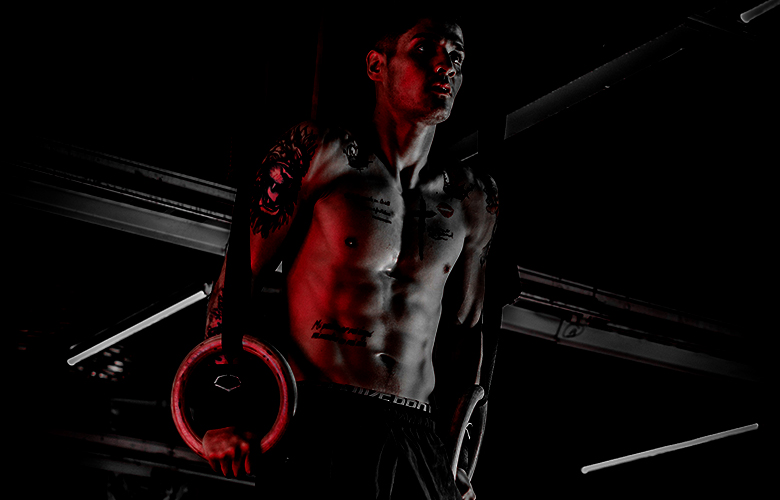
Hey all, I hope you are safe, healthy, and doing the best you can during the ongoing coronavirus craziness. My thoughts are with everyone who has been impacted by the virus. Whether that be health-wise, personally, mentally, or financially, I wish you nothing but the best. Today I wanted to dive into a blog that was highly requested from the SHIFT community. It covers many of my current thoughts, and pieces of advice related to how to safety return to training gymnastics once this is all over.
I will be the first to admit it: this flat out sucks.
I am in the same position as many other people in the gymnastics community. I’m worried about my own health, my friend’s health, my family’s health, our gym being closed, making ends meet financially, my own business possibly getting crushed, not knowing how long this will last, and 100 other things.
But before I give any advice about gymnastics and how to approach this off-time/return to training, I have to start with this: Controlling the virus spread, helping sick people, and following the advice of the scientific experts, are far more important than sports right now.
There is no way around it, this coronavirus is highly contagious and we still don’t know a lot about it. At this point, this virus situation is here and there is much out of our control. We have to focus on what we can control, what we can do at this time, and how we can continue to serve the gymnasts we work with.
Continuing to stay in touch with your gymnastics community is essential right now. Whether it is purely to express your gym’s policies and approach to COVID-19, or to continue hosting some version of a virtual practice, it’s all great. I highly suggest connecting with Zoom, Google Hangouts, group FaceTime, or other services.
First off and most importantly, touch base with them on the human level. Sometimes we just need good social support to vent, talk about anxieties/fears, or air out some worries which is massively helpful for people. Especially as many people share the same fears, hearing their peers express that (or even a role model/coach) can ease lots of tension.
We have a tradition of playing Scattergories for a half-hour at the end of a long training week when the practice is done on Saturday. We have been continuing that tradition on Zoom weekly, and it’s great for all of us.
In terms of training are ideas ranging from less gymnastics based/best intense to more gymnastics based/more intense
Outside of your non-gymnastics chats, we have big plans currently being built for coaching education online, staff chats for program development, individual Zoom meetings for coaches with their levels to work on stuff, and we have built a big home 6-day program for our teams (you can download it for free here if you want to use it). My boss put together some amazing at home drills/basics to do for each event, putting a few events on each day. This leads to number three.
First off, the continued exercise is good for physical and mental health which is clearly more important. But from a gymnastics and workload point of view, there is good evidence to suggest that maintaining workload may reduce the total time it takes to get back to full training down the road. Most gyms and gymnasts are well ahead on this one, but I had to include it here and expand on some concepts.
Of course, we would all like the gymnasts to be continuing to exercise and stay fit at home. But keep in mind, I think it’s really important to connect with the gymnasts in relation to their goals to maintain motivation.
Just throwing a program at gymnasts, or saying they ‘should’ workout, is not a good plan to make things stick. Have the gymnasts map out skills they want to get, goals they have, or what they need to move up in level for next year. Then, take these goals and map them back to how doing a home program can help them hit the ground running once we get back to the gym. It’s no different than healthy vs unhealthy forms of motivation during training.
We have no idea how long this thing will go on for, and how long it will take until group gatherings (aka gymnastics training) is permitted. We could easily be looking at a minimum of 1-2 more months of this. For that reason, every week we are out of the gym it becomes more important to try and maintain some percentage of a general workload.
This 2015 study I have talked about before from the Australian Institute of Sport across multiple sports looked at how maintenance of partial workload helped reduced the time taken back to total training following an injury.
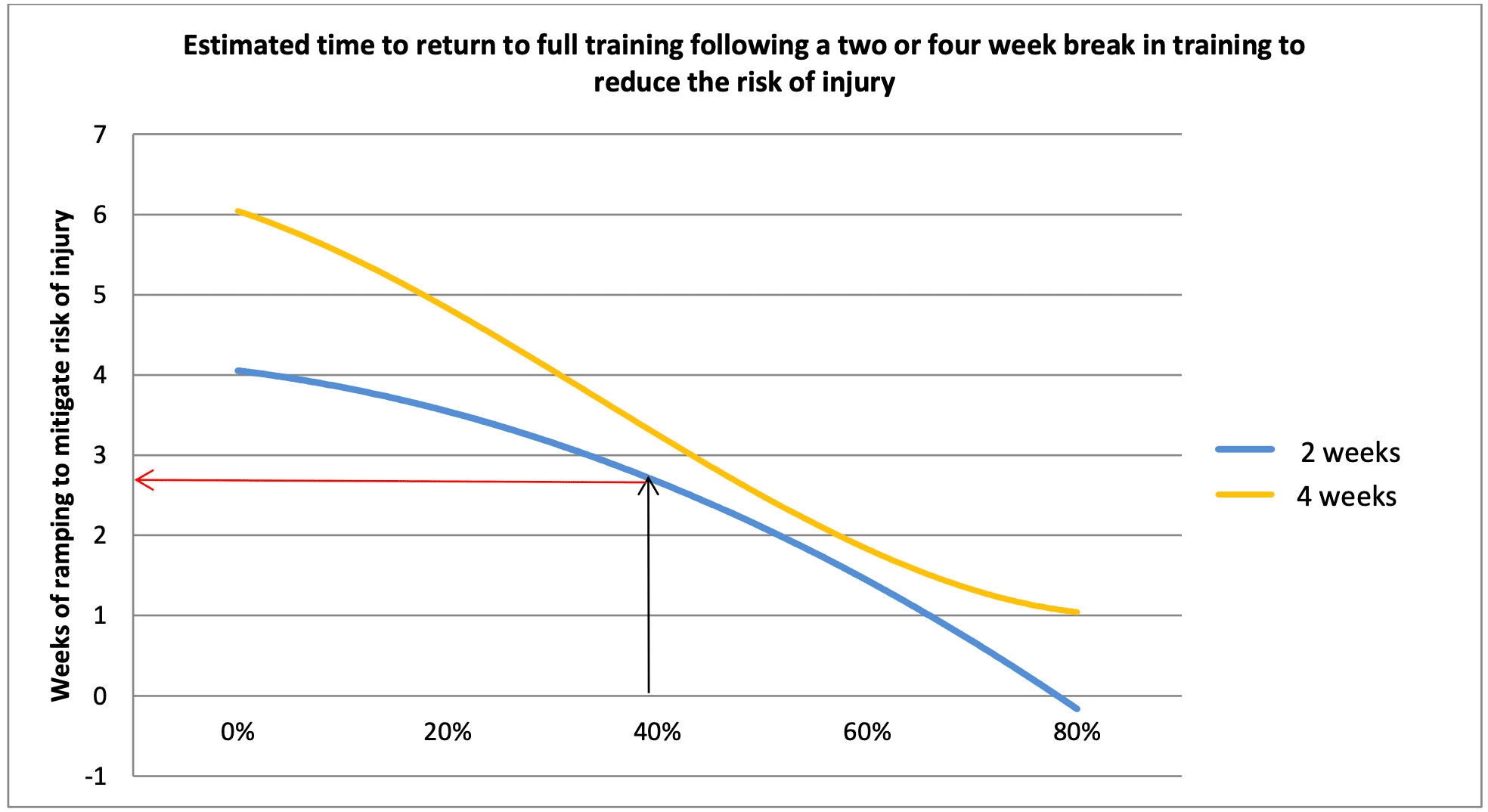
As you can see by this graph, being able to maintain a fraction of workload may help shave weeks off returning back to full training. In this study, injury was the limiting factor so it’s likely there were boundaries on how they could train. The plus side for our situation with coronavirus is although we can’t get into a gym for technical training, most people aren’t limited by an injury.
This means we can get a high volume of strength, cardio, flexibility, and core work in. If gymnasts can get into a schedule of working out at home 5-6 days per week, it can maintain a good amount of workload.
Keep in mind, this can include following a home fitness program but also things like yoga, getting outside for walking/running/biking (while respecting social distancing) and more. These things will not only help mental clarity and structure but also make a big impact on their ability to safely return back to the gym when things blow over.
There is really no way to avoid the fact that everyone is going to have some rust in their gears once we get back to training. Personally, I actually think this is a good thing to test/simulate what a 4 week off-season would look like in our sport. That being said, we may be looking at 2-3 months that is not ideal.
Now don’t get me wrong, we are all going to be absolutely ecstatic to be back in the gym with friends and doing what we love. But this is where the warning needs to be respected. Mentally and energy-wise gymnasts will be ready for 5th gear. Physically, not so much.
As I have discussed before, some notable research cautions against significant spikes in training workloads. There may be a significant increase in injury risk when a high acute load (like the first week back of training volume) occurs on top of a very low chronic load (like from having 3-4+ weeks off from gym due to coronavirus).
This is referred to as the “acute to chronic workload”. I will say that this model is currently taking some heat from the literature point of view, especially in regards to the mathematics behind it and injury risk. But, I still think for now it’s valuable and is much better than doing nothing at all.
It’s absolutely crucial that gymnasts, coaches, parents, and medical providers are hyper-aware of training loads and the body’s responses to training loads. For most people, it’s recommended that we don’t spike the training significantly week to week, represented by an acute to chronic workload of .8-1.3. You don’t need to get super in the weeds with numbers, but what it means is we need a slow rolling start over a few weeks, with minimal jumping in intensity, volume, or total high load done week to week.
This is a pretty well-known graph from this concept to look at. It’s from a few sports combined but has since been studied in many other sports. And like I said, there is some scrutiny behind its methods. Even Tim Gabbett and others will be the first to tell you not to only look at the numbers, and make sure you have a regular conversation with your athletes (more below). But, the concepts are still good to keep in mind.
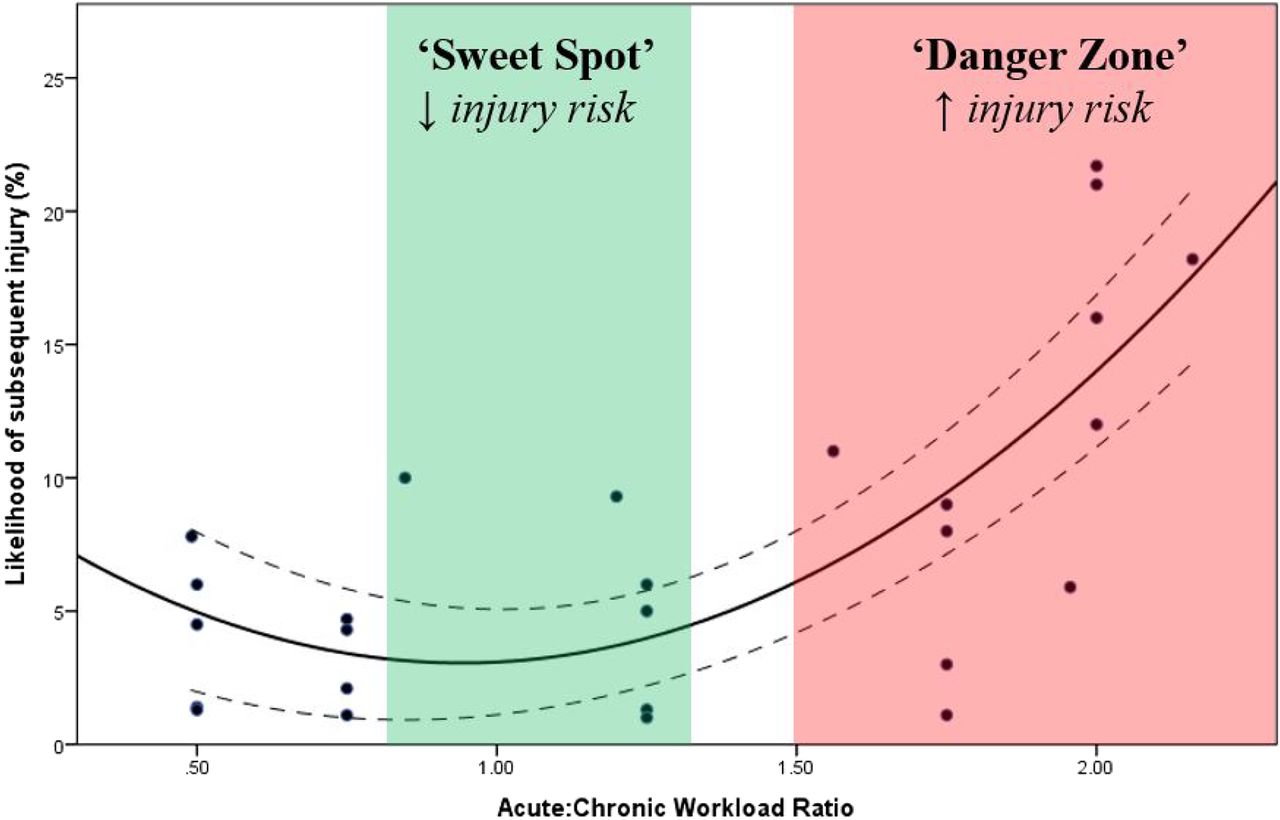
Here are 3 things I suggest to safely increase training load and get athlete feedback when we get back into the swing of things.
Use Session RPEs.
Session RPE multiplies the minutes of training times by an athlete’s rating of difficulty 1-10. 1 is the least demanding, 10 is the most demanding. So for example, a 3-hour practice that athlete rates as a 7/10 would be 360 x 7 = 2,520.
Gymnasts can easily do this at the end of each practice if binders are set up, and use their phones for a quick calculation. Although it is not super detailed, it’s an easy way to see how training loads are going when getting back.
You can then start to look at the day to day intensities, and encourage gradually building up training load over the course of 4 weeks (my suggestion). This obviously isn’t feasible with all gymnasts or very young athletes, but for many it’s important information to know. This is a screen shot from a more complex system I’m building, but it’s useful to see what can be created over time with basic workloads and wellness scores (more below).
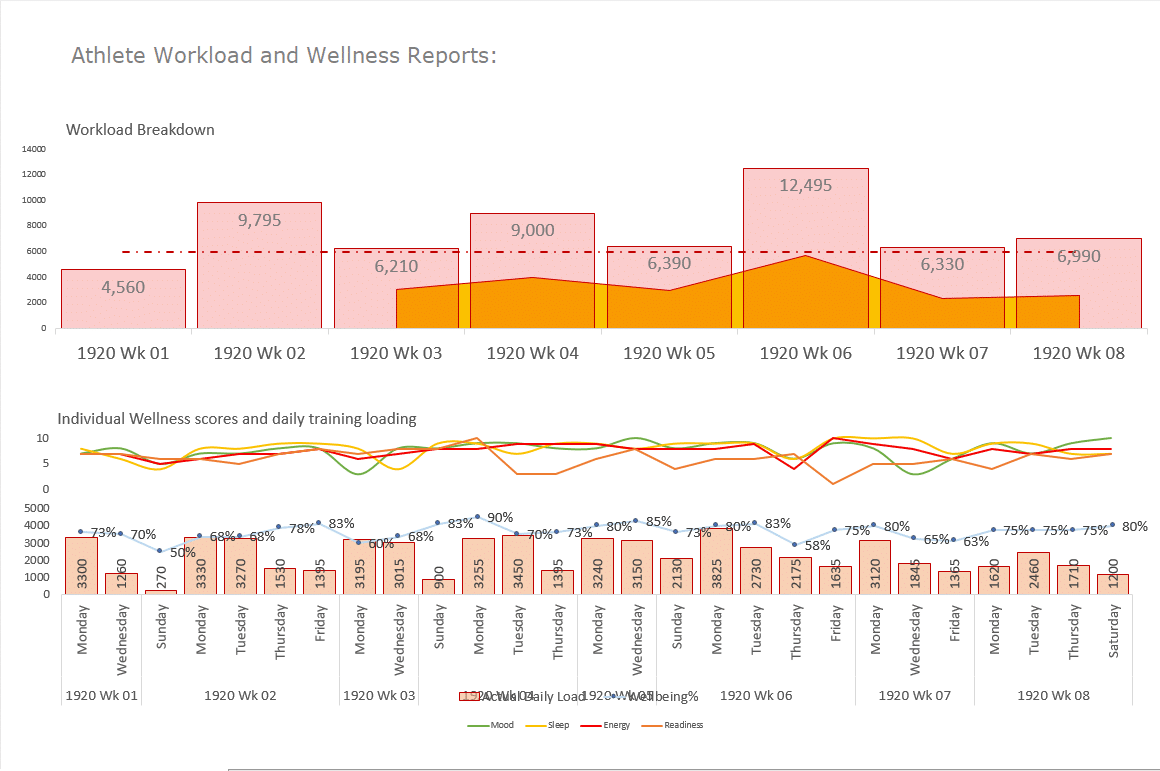
Use Wellness Scores.
In combination with RPEs, wellness scores are another fantastic way to gauge how athletes are feeling. I recommend having athletes use a 1-10 scale for 4 things each day before practice.
Then, you can add these scores up and divide by 40, then multiply by 100 to get a “wellness score” that is a percentage. For example 7+8+6+7 = 28/40 x 100 = 70%.
Session RPEs will help narrow in on the actual training load, whereas the wellness score will help narrow in on the athlete’s mental and physical wellbeing.

Rebuild with Basics, Play with Soft Surfaces.
We 100% want to let our gymnasts play, have fun, and get excited about gymnastics again. BUT we have to protect them from themselves. We need to be very careful about hard surfaces, high repetition numbers of skills, and getting carried away.
I suggest that people spend 50% of their time on basics, having fun with gymnastics style games, and reconditioning the body for gymnastics. The other 50% for skill work I suggest be using pits, softer surfaces, trampoline/Tumbl Trak, spotting, and other low force situations. I would suggest spending the entire first month back in this environment once we get going.
For the first time ever, gymnastics is going to have a relative off-season, like I said that is longer than the hoped-for 4 weeks, and a much longer pre-season. Regardless of whether you’re a fan of gymnastics having an off-season or not, it’s now a part of our next year puzzle.
With this in mind, I think that everyone is going to have to rethink the pace, intensity, and duration of off-season. On the one hand, it is great that we will have more months to work on new skills and upgrades.
On the other hand, all of us are going to be coming off a period of very low training loads. So we are going to want to be really careful about diving into those new skills. Start brewing up your drills, progressions, and spotting ideas while you have some time on your hands.
If you want to learn more about this, I offered a massive free online lecture HERE on planning the competitive year you can check out.

Without a doubt, I think we are going to have to really spend time on the mental and emotional health of our gymnasts. Initially, we are going to have excitement and tons of mental readiness to dive into new skills and having fun. We really do want to promote this, and let athletes be excited, but at the same time, we need to be really careful here. The huge mismatch between mental excitement and physical deconditioning is going to be huge.
When the time comes, we will have to do a really good job of educating gymnasts and parents on the balance of getting back into the gym and having fun, but not pushing too hard. In my mind, I think that conversation has to start now virtually or through other communications, and not when we get back to the gym. Do yourself a huge favor and get that going ASAP.
On the other side, we are going to be very, very patient with everyone when we get back to the gym. It is going to take more time than usual for gymnasts to get the rust out, and get back into shape. There will be lots of emotions running high in the first month back from gymnasts and parents. We need to do our best as coaches and leaders to be patient, accept what we can vs can’t control, and be there with unconditional support for the athletes.
I’ll be the first to tell you that I would rather be out and about coaching, seeing patients, and traveling to events that were lined up. We all would rather be living our lives and enjoying things. But, that’s not what’s happening. Like everyone else, the last week for me was simply wrapping my head around work and how to reallocate time. While there are great benefits for family and more space to think, many of us have unwanted extra time on our hands.
The best thing we can do here is embrace the reality and deal with it. Take a big step back and think about what you can do with the extra time you have for yourself, the gym you are a part of, your friends/family, and athletes you work with. While there are constraints, there are lots of things that can be done to keep moving forward. Some of the ways I’m spending my time to prepare for the future are:
Nutrition, Mental Toughness And Recovery
Dealing with Stubborn People in the Workplace: 7 Tips
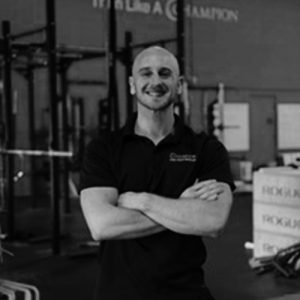

Dave Tilley DPT, SCS, CSCS is a Physical Therapist who graduated in 2013 from Springfield College. Dave comes from an extensive gymnastics background, being a former athlete and currently still coaching optional level gymnastics in Boston. Dave was a competitive gymnast for 18 years, 4 of them collegiately as part of the Springfield College Men’s Team. Dave has also been coaching gymnastics for 12 years, being involved in beginner, national, and elite levels. His unique background as a former athlete and current coach gives him a one of a kind approach for the performance and rehabilitation of gymnasts. He has successfully treated some of the most talented high school, collegiate, and junior elite level gymnasts in the country. Along with gymnastics, Dave enjoys treating athletes of all sports as well as the specialized treatment of Olympic Weightlifters and CrossFit athletes. He has worked with regional and national level Olympic Weightlifters, as well as Regional and Games level CrossFit Athletes. Dave graduated from Springfield College with his Bachelors in Science, a Minor in Psychology, and Doctorate in Physical Therapy. He became Board Certified in Sports Physical Therapy in February of 2016, and became a Certified Strength and Conditioning Coach in 2017. His current interests include prevention and rehabilitation of extension based spine injuries, shoulder and hip instability, periodization and strength and conditioning models, as well as the science involved in long-term athletic development, mobility training, and motor control. He participates in ongoing continuing education by attending various courses, collaborating with other professionals, and staying up to date with the most current medical research. Along with treating in the clinic, Dave is also the CEO/Founder of “SHIFT Movement Science and Gymnastics Education”. This company was started in 2014 to help educate those involved in gymnastics, medical fields, Olympic weightlifting, CrossFit, and more about optimal performance and preventative rehabilitation strategies. By combining his roles as a healthcare provider, current coach, and athlete Dave looks to help remold the gymnastics world with current, scientifically backed principles that optimize a gymnast’s long-term potential. His new forward-thinking ideas have been nationally recognized with members of USA Gymnastics, being implemented into JO, Collegiate, and Elite level programs. Dave travels to speak both nationally and internationally at various events across the country including Make It Right Elite Gymnastics Camp, USAG Regional, and National Congress, Power Monkey Camp in Tennessee, and has consulted with many NCAA Division 1 Men’s and Women’s Gymnastics. Dave is very passionate about his work both in the clinic and gymnastics training arena. He aims to deliver the best possible care to the clients he sees and athletes he trains. He hopes to soon become more active in the role of conducting research studies related to gymnastics. Dave is the newest addition to the Champion Physical Therapy and Performance Team.
Read Full Profile© 2021 TheatreArtLife. All rights reserved.
Notifications